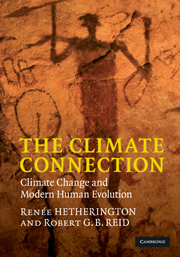Book contents
- Frontmatter
- Contents
- Foreword
- Preface
- Acknowledgements
- 1 Introduction
- Part I Early human history
- Part II Climate during the last glacial cycle
- Part III The interaction between climate and humans
- Appendices: The biological background to the story of evolution
- Appendix A Evolutionary theory
- Appendix B Developmental evolution
- Appendix C Human adaptability: the physiological foundation
- References
- Index
- Plate section
Appendix B - Developmental evolution
Published online by Cambridge University Press: 05 August 2012
- Frontmatter
- Contents
- Foreword
- Preface
- Acknowledgements
- 1 Introduction
- Part I Early human history
- Part II Climate during the last glacial cycle
- Part III The interaction between climate and humans
- Appendices: The biological background to the story of evolution
- Appendix A Evolutionary theory
- Appendix B Developmental evolution
- Appendix C Human adaptability: the physiological foundation
- References
- Index
- Plate section
Summary
Introduction
At the close of Appendix A we emphasized that during the course of evolution, changes in organismal development from a fertilized egg to an adult result in altered anatomical features. Some changes during the development of an individual organism result from changes in behaviour, for example exercise alters the size and strength of muscles and can also affect skeletal structure. Although it is not widely believed that such changes are passed on to later generations, we cannot rule out the possibility altogether. Also, it is almost axiomatic that, as Aristotle said, ‘Nature is true to type.’ Cats beget cats, dogs beget dogs and humans beget humans. To explain this, some modern biologists use the metaphor of a computer programme, or algorithm, which is responsible for such consistency in development. In any case, during the course of evolution, consistency of development was periodically interrupted, and developmental pathways were altered. Otherwise, the most complex organisms would still be microscopic single cells, or small aggregates of several identical cells. Therefore, to understand how humans emerged from ape-like ancestors we must be as familiar as possible with normal developmental processes, and all of the factors that cause them to change, from mutations of DNA to environmental influences.
Epigenesis and epigenetics
Even prior to Darwin, it was clear to some evolutionists that the diversity of living forms had to have resulted largely from modifications that occurred during embryonic and juvenile development, a process known as ‘epigenesis’.
- Type
- Chapter
- Information
- The Climate ConnectionClimate Change and Modern Human Evolution, pp. 319 - 334Publisher: Cambridge University PressPrint publication year: 2010



